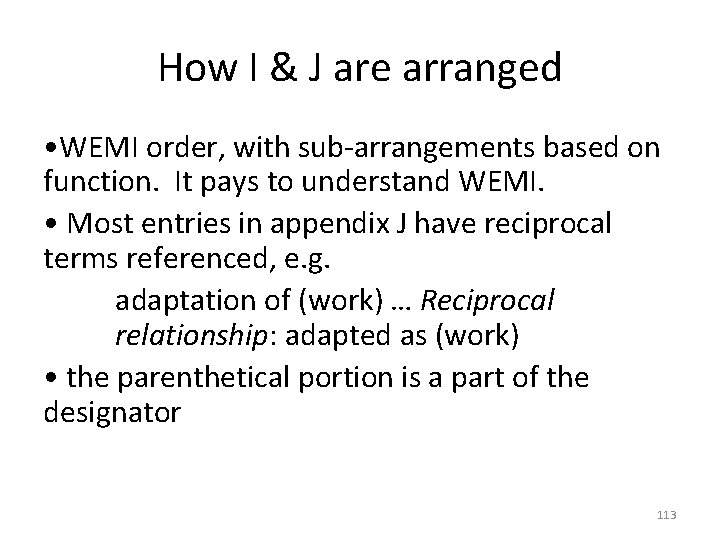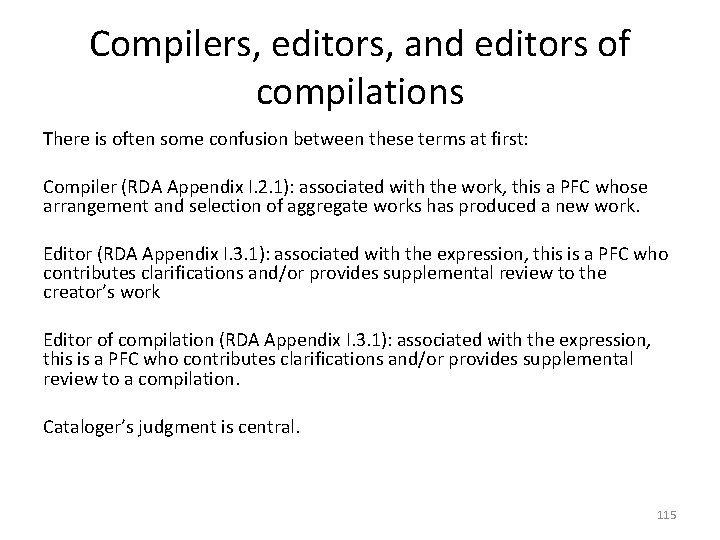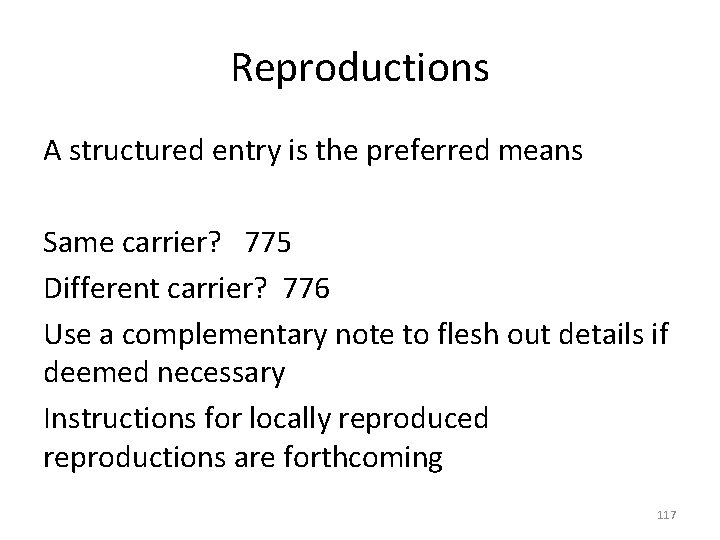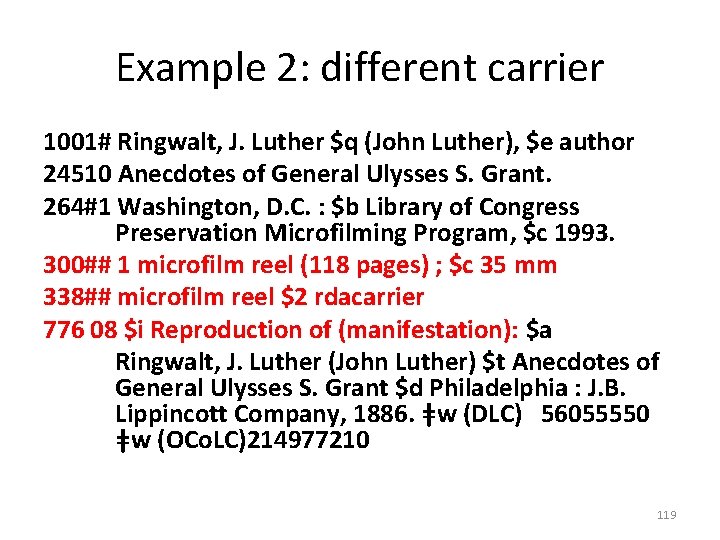Authorized Access Points Or How I learned to

























![Examples of AAPs & subject headings 1003# Aiken family [subject] 1003# Aiken (Family : Examples of AAPs & subject headings 1003# Aiken family [subject] 1003# Aiken (Family :](https://slidetodoc.com/presentation_image_h2/0b33288be99e3ff9e7990c4bd6ba1a0c/image-26.jpg)






























































































- Slides: 120

Authorized Access Points Or, How I learned to stop worrying and love RDA 1

Learning Objectives For the 1 st Segment • Increased familiarity with the philosophical ins and outs of authorities and AAPs (Authorized Access Points; formerly known as “headings”) in RDA • Have a general idea of how RDA authorities are different (and the same!) from authorities under AACR 2 • Have general understanding of how to use authorities • How to formulate AAPs in the absence of an authority • Where to find out more when you need it 2

Terminological prolog • AACR 2 : Heading RDA : Authorized Access Point = AAP • When I say “record, ” I mean “authority record. ” When I mean “bibliographical record, ” I will say as much. If I slip (and I may), ask. • PFC: Person, Family, or Corporate Body 3

FRAD Functional Requirements for Authority Data Extension to FRBR delineating what authorities do 4

Those principles? • • 1. Find 2. Identify 3. Clarify/Justify 4. Contextualize 5

What it means The meaning is simple: authority records function pretty much as they did under AACR 2. Under RDA however, the principles of identification and contextualization have a much more prominent place and authorities have been expanded to accommodate this reemphasis. 6

And that leads to … 7

RDA vs. AACR 2 8

Meet Fekete István, 1900 -1970, was a celebrated Hungarian author in the mid-20 th century who wrote novels for young people and animal stories. We’ll be looking at his authority record on and off for the next few slides 9

An Example of an authority record 10

The things that are the same • Authorities still do what they have always done, and all of the old fields are still pretty much the same. • Authorities are still used in the bib records in pretty much the same way • OCLC still allows for controlling authorities and bibs 11

The things that are different • There a host of new MARC fields in authority records • An expanded role and list of distinguishing terms and conventional collective titles for works/expressions/uniform titles • Changes to fixed fields and 040 • Dates and 046 • Family records • An increased number of Works/Expressions authorities 12

New MARC fields • For all authorities - 046 dates - 370 associated place - 372 field of activity - 373 associated group - 377 language • Personal names only - 374 occupation - 375 gender - 378 fuller form of name • Personal names and Corporate bodies - 368 other attributes of person or corporate body • Family names only - 376 family information • Works, expressions only - 336 content - 380 form of work - 381 other characteristics • Music only - 382 medium of performance - 383 numeric designation - 384 key 13

When in doubt MARC field help in OCLC will answer most of your questions. DEMO GOES HERE 14

Distinguishing terms and collective titles • Personal names: - Professions may now be used to break conflicts - RDA 9. 6. 1. 9: “other designations”= anything, but only when other categories aren’t available • Works, expressions, Uniform titles: - there are no restrictions on which terms to use • Conventional collective titles - $t Selections has been eliminated 15

Fixed fields and 040 The principal mark of distinction between an RDA authority and an AACR 2 authority are the designations in the fixed fields and the 040 AACR 2 008/10 “Rules”: C RDA 008/10 “Rules”: Z AACR 2 040: CU $b eng $c CU RDA 040: CU $b eng $e rda $c CU 16

Example: RDA Rules and 040 17

046 and dates Dates have become more important and more applicable under RDA. A new MARC field, 046, is used for recording the dates, even if they are not used in the AAP. 18

Example: RDA 046 19

Date notation in the AAP The notation for recording dates in the AAP has also changed, notably: • no more b. [date] or d. [date]. Instead “[date]-” to indicate only a known birth date or “–[date]” to indicate a known date of death only • all abbreviations have been replaced with full words, e. g. , “c. ” for “circa” has been replaced with “approximately. ” 20

Authorities for Families Records for families have in the past been used exclusively as subject headings. Under RDA however families now may be considered creators or subjects, but with discrete records. 21

Creators or subjects? Unlike personal names, authorities for families as creators require discrete records from authorities covering the same family as a subject. 22

Families as subjects The tell-tale markers 1) 008/14 “Name use”: b (“heading not appropriate for main or added entry”) 2) 008/15 “Subj. use”: a, meaning it is appropriate for subject use. 3) The word “family” will be appended directly to the AAP and Variant Access Points (VAPs) e. g. Williams family 4) Is used to refer to all branches 23

Families as creators The tell-tale markers 1) 008/14 “Name use”: a (“heading appropriate for main or added entry”) 2) 008/15 “Subj. use”: b, meaning it inappropriate for subject use 3) The word “family” or a related descriptive term will be appended parenthetically to the AAP and Variant Access Points (VAPs) 4) Refers to a specific branch 24

Families as creators Creator authorities for Families have a specific structure where certain terms and facts have to present in a specific order if known 1. The name of the family 2. The type of family (family, clan, royal house, or dynasty) 3. Dates if known 4. Place if known 25
![Examples of AAPs subject headings 1003 Aiken family subject 1003 Aiken Family Examples of AAPs & subject headings 1003# Aiken family [subject] 1003# Aiken (Family :](https://slidetodoc.com/presentation_image_h2/0b33288be99e3ff9e7990c4bd6ba1a0c/image-26.jpg)
Examples of AAPs & subject headings 1003# Aiken family [subject] 1003# Aiken (Family : ǂd 1854 -1981 : ǂc Conn. )[creator] 1003# Asher family [subject] 1003# Asher (Family : ǂc Worcester, Mass. ) [creator] 1003# Blomstrand family [subject] 1003# Blomstrand (Family: ǂc Sweden) [creator] And just so you can see the types in action …. 1003# Chichibu no Miya (Royal house) [creator] 1003# Romanov (Dynasty : ǂd 1613 -1917) [creator] 26

Inquiring minds want to know The term “clan” is undefined in the instructions, thus I give you the first definition from entry for “clan” in the on-line OED 1. A number of persons claiming descent from a common ancestor, and associated together; a tribe. 27

Exam #1 The first of two over the course of the day. Please follow the directions beneath each record. 28

The answers 29

But wait! There’s more! A bit later in this presentation we’ll discuss the ins and outs of creator authorities for families. Be patient, it will come. 30

More! Works/Expressions authorities A tidal wave of authorities representing works/expressions is upon us. RDA’s philosophical reconfiguration of bibliographical description necessitates more control points within bib records, which in turn generates a need for authority control (in an ideal world, anyhow) 31

On-going changes RDA instructions and the various policy statements are constantly evolving. 32

RDA-ization Programmatically updating AACR 2 records to RDA 3 phases, we’re in the third Previous 2 were done mechanically, the 3 rd as encountered by catalogers Some records only had 667’s inserted to reflect that they would have to be done by hand. 33

667 s related to updating AACR 2 authorities • THIS 1 XX FIELD CANNOT BE USED UNDER RDA UNTIL THIS RECORD HAS BEEN REVIEWED AND/OR UPDATED– This one is important and we will see it again. • Machine-derived non-Latin script reference project. • And so on. 34

Hybrids are records in which the AAP is composed of two distinct portions in which the first portion is controlled by an AACR 2 record, but the dual form is RDA. e. g. , University of Colorado, Boulder. ǂb University Libraries Hybrids are permitted for the time being, though their future seems uncertain. Expect policy changes. 35

Meet the NACO Liaison He can answer your questions rtalbott@library. berkeley. edu 36

Using Authorities Or, The wonders of being blue 37

The authorities dance for catalogers 38

Copy Cataloging • Oh frabjous day! Take what you see! • … Unless there’s an obvious problem (clearly not the right person, etc. ). Follow the steps under “Original cat” (we’ll get there in a couple of minutes). • Always remember that in a bind, you may consult the NACO liaison DON’T PANIC 39

Deriving and upgrading bibs Verify AAPs by trying to control them in OCLC Here’s method I use, but there others • Move cursor to field to be controlled • Right click and select from menu and select “Control Single Heading” • From the “Control headings” dialog box, select the correct heading • The bib record reappears, and the field turns blue 40

It’s turning blue! • There’s an authority record there! • Verify that the authority you’ve just linked to is reasonably correct 41

Reasonably verifying • Look at any biographical description on the piece • Compare with data in authority, esp. 670’s • Authors tend to mine specific veins of knowledge. In the absence of solid biographical confirmation, look at the kinds of books the person writes • Undifferentiated records may be okay. Check with the NACO liaison before using 42

Undifferentiated authority • Undifferentiated authorities are a special class of authorities that track names for seemingly separate people who, because of lack of resources cannot be distinguished • Distinguishable by the 670 structure: 670## [Author of XYZ] 670## XYZ, 2012: $b t. p. (Jim Smith) 43

An example of an undifferentiated authority 44

It’s not turning blue? Or The authority you just linked to is obviously not the one you want? Don’t panic. We’ll check the authority file, which we’ll get to in a couple of minutes. 45

Original Cat The authority file must be checked on OCLC The authority file must be checked on OCLC 46

How to check OCLC authorities • There are couple of ways – Browsing: Click on “Authorities” from toolbar then click on “Browse LC names and subjects”. This will meet 90% of your needs – Search: Shift + F 2 is one way. Good for dealing with complex lists (e. g. jurisdictions, corporate departments, etc. ) Be sure to use the right index: if you’re looking for a personal, search the “Personal names” index. 47

You’ve found the right record • You searched the authority file, located a likely record, took a look at it and have decided that in fact it reasonably represents what you’re looking for and it’s RDA • Use it and be done • Remember undifferentiated records? One may be okay, but you might consider checking with the NACO liaison before you use it. 48

You’ve found the right record but it’s AACR 2 • RDA or AACR 2 without is okay to use • But if it’s got a 667 “THIS 1 XX FIELD CANNOT BE USED UNDER RDA UNTIL THIS RECORD HAS BEEN REVIEWED AND/OR UPDATED” … This 667 indicates the AACR 2 record is … non-RDA compatible 49

It’s quite the pickle … but we have 2 possible answers 1) Per our local policy, we may use AACR 2 authorities in an RDA bib record if we code the bib as Elvl: K. This will solve most of your problems 2) Have the NACO liaison upgrade the record 50

You looked in the AF and found nothing We have two options when a reasonably appropriate authority can’t be found in the AF 1) Have the NACO liaison create an authority Or 2) Float an AAP Option 1 has a lot of utility, but it’s not appropriate to every situation. When in doubt, ask. 51

Having a heading created You checked the Authority files, right? If nothing is found in Authority File, contact the NACO liaison to get the ball rolling. The NACO liaison or a related trades-person will need to see the piece where the name is taken from, so keep it nearby. 52

Floating an AAP You checked the authority file, right? If nothing is found in the Authority File, it is permissible to float an AAP. By “float, ” we mean to anticipate what the AAP would like if the correct authority existed (but doesn’t) and to use the same. 53

How to float an AAP The key to floating an AAP is anticipating what the AAP would be if there were an authority. There 4 number of types of headings commonly encountered, each with their own nuances Personal names Corporate bodies/Conferences Works/Expressions/Uniform titles Families 54

Something to keep in mind • 90% of cases people will encounter, only names will be involved—no dates, no professions, etc. • The particulars are a little different, but this is the same thing we have always done in some cases. DON’T PANIC 55

Something else to keep in mind Finding the right authority can be confusing, but fear not, the NACO liaison is here to help 56

Floating personal names You’ve checked OCLC’s Authority File, right? • Follow the instructions in RDA 9. 19 for selecting the preferred form of the name. • If dates are present on the piece, include them. • If there is still a conflict with another name in the AF, use an accurate, properly coded distinguishing term, e. g. , $c (Plumber). Types of distinguishing terms may be found in 9. 1. 57

Floating corporate names You’ve checked OCLC’s Authority File, right? • Follow the instructions in RDA 11. 13 for selecting the preferred form of the name. • RDA 11. 13. 1. 2 -11. 13. 1. 7 provides terms and elements that may be used to break conflicts 58

Floating conferences You’ve checked OCLC’s Authority File, right? • The instructions for corporate bodies in RDA 11. 13 also apply to conferences • We still use parenthetical numbering, dates, and place when apparent • Generic conference authority vs. specific conference authority 59

Floating works/expressions You’ve checked OCLC’s Authority File, right? • RDA 6. 27 -6. 31, but mostly RDA 6. 27 and 6. 30 • Preferred form plus distinguishing term if required 60

WARNING! The hierarchies for sacred texts have changed AACR 2: Bible. $p. O. T. $p. Ezekiel RDA : Bible. $p Ezekiel 61

Floating families You’ve checked OCLC’s Authority File, right? • Family name or subject? : do not use the subject AAP for the creator AAP. It does not compute. • Follow the established algorithm instead: either have an authority created, or float one. • But Bob, how does one go about “floating” a family name? Can we really do this? 62

I’m glad you asked And yes, you may. • Following RDA 10. 10, use the preferred form, which is the surname • Mandatory: add the family type (RDA 10. 3) and date(s) associated with the family in that order inside parentheses • If required to distinguish: add a place name associated with the family and/or the name of a prominent member, also within the parentheses 63

Don’t forget! • Both kinds of Family authorities are indexed under “Personal name” in OCLC 64

Break? 65

Learning Objectives For the 2 nd Segment • Be able to distinguish collaborative works from compilations • Have a general understanding of the various types of collaborations, compilations and the respective consequences (and how these things dramatically tie in with Authorized Access Points) • Have an understanding of conventional collective titles as they exist within RDA • And finally, be able to find the appropriate relator term in the RDA Toolkit and use it correctly 66

Collaborations vs. Compilations • Collaborations: RDA 6. 27. 1. 3 • Compilations: RDA 6. 27. 1. 4 Compilation Collaboration 67

Is it a collaboration? • You have no idea who created what; single work two or more creators • You are in doubt • Creator is either the principal creator or the first mentioned creator • Remember: no more rule of 3! 68

The 2 kinds of collaborations • With principal responsibility • Without principal responsibility 69

Collaboration with principal responsibility: an actual title page 70

Collaboration with principal responsibility example Under AACR 2 1001# Murphy, Evelyn F. 24510 Getting even : $b why women don’t get paid like men– and what to do about it / $c Evelyn F. Murphy with E. J. Graff. 7001# Graff, E. J. 71

Collaboration with principal responsibility example The RDA version 1001# Murphy, Evelyn F. , $e author. 24510 Getting even : $b why women don’t get paid like men– and what to do about it / $c Evelyn F. Murphy with E. J. Graff. 7001# Graff, E. J. , $e author. Good news! It’s just like AACR 2, except the 700 entries are optional. 72

Collaboration without principal responsibility: an actual title page 73

Collaboration without principal responsibility example pt. 1 Under AACR 2 24500 Prego : $b an invitation to Italian / $c Graziana Lazzarino … [et al. ]. 7001# Lazzarino, Graziana. 74

Collaboration without principal responsibility example pt. 2 But under RDA the work looks like this: 1001# Lazzarino, Graziana, $e author. 24510 Prego : $b an invitation to Italian / $c Graziana Lazzarino, Janice M. Aski, Andrea Dini, Maria Cristina Peccianti. 7001# Aski, Janice M. , $e author. * 7001# Dini, Andrea , $e author. * 7001# Peccianti, Maria Cristina, $e author. * *Nice, but not required. 75

Is it a compilation? • an indication of who created what (any number of possible creators, from 1 to infinity) • an indication from somewhere on the piece stating that it qualifies as a compilation, e. g. terminology, an indication on the chief source, table of contents, etc. 76

The 4 kinds of compilations • Multiple works with 1 creator • Multiple works, multiple creators, and a collective title proper (manifestation) • Multiple works, multiple creators sans collective title proper (manifestation) • Multiple expressions of the same work 77

Compilation: multiple works by one author • Treat as compilation since there are no other creators • Identified by Creator plus preferred title • Preferred title for 1 creator, multiple works: RDA 6. 2. 2. 10 -Is it known by a Title? ○Not usually, but exceptions like “Leaves of grass” exist. When in doubt, check reference sources. - Almost all will have a conventional collective title ○ More on this later 78

Compilation: 1 creator, multiple works example: an actual t. p. 79

Compilation: 1 creator, multiple works example: what it looks like in AACR 2 1001# Dick, Philip K. 24010 Short stories. 24514 The collected stories of Philip K. Dick / $c introduction by Norman Spinrad. 5051# -- Volume two. We can remember it for you wholesale -7001# Spinrad, Norman. 80

Compilation: 1 creator, multiple works example: what it looks like in RDA 1001# Dick, Philip K. , $e author. 24010 Short stories. 24514 The collected stories of Philip K. Dick / $c introduction by Norman Spinrad. 5051# -- Volume two. We can remember it for you wholesale -7001# Spinrad, Norman, $e writer of introduction. * *Optional, but still nice. 81

Compilation: multiple works by multiple creators with a collective title proper (manifestation) Remember, we know who has done what, so it’s a compilation • No principal creator (bet on an editor being present) • Preferred title – Title proper of the manifestation (common) 82

Compilation: multiple works by multiple creators with a collective title proper (manifestation) t. p. 83

Compilation: multiple works by multiple creators with a collective title proper (manifestation) AACR 2 example 24504 The discerning reader : $b Christian perspectives on literature and theory / $c edited by David Barratt, Roger Pooley, Leland Ryken. 7001# Barratt, David. 7001# Pooley, Roger. 7001# Ryken, Leland. 84

Compilation: multiple works by multiple creators with a collective title proper (manifestation) RDA example 24504 The discerning reader : $b Christian perspectives on literature and theory / $c edited by David Barratt, Roger Pooley, Leland Ryken. 7001# Barratt, David, $e editor of compilation. 7001# Pooley, Roger , $e editor of compilation. * 7001# Ryken, Leland , $e editor of compilation. * *Optional. 85

Compilation: multiple works by multiple creators without a collective title proper (manifestation) • There is no principal creator • For the preferred title, use the title proper (manifestation) of the first work and • Use an analytic AAP for the first or predominant work • Fair warning: this is very different from AACR 2 and will break your brain if you’re not careful 86

Compilation: multiple works by multiple creators without a collective title proper (manifestation) 87

Compilation: multiple works by multiple creators without a collective title proper (manifestation) example 1 1 st, the AACR 2 version 1001# Zelazny, Roger. 24510 Home is the hangman/ $c Roger Zelazny. We, in some strange power’s employ, move on a rigorous line / Samuel R. Delany. 500## Title from spine. 70012 Delany, Samuel R. $t We, in some strange power’s employ, move on a rigorous line. 88

Compilation: multiple works by multiple creators without a collective title example 2 And now, the same book described under RDA 24500 Home is the hangman / $c Roger Zelazny. We, in some strange power’s employ, move on a rigorous line / Samuel R. Delany. 500## Title from spine. 70012 $i Contains (work): $a Zelazny, Roger. $t Home is the hangman. 70012 $i Contains (work): $a Delany, Samuel R. $t We, in some strange power’s employ, move on a rigorous line. 89

Multiple expressions of same work • LC-PCC PS for 6. 27. 3: When the original expression and one translation are in a compilation, give an analytical authorized access point for each expression. If a compilation contains the original expression and more than one translation, give analytical authorized access points for the original expression and at least one translation. • This is the one that pays the dividends, folks. 90

LC PCC PS 6. 27. 3 Example The classical example of a compilation of expression of the same work: Please note that the example does not give any relationship terminology. It’s a bit dated in that regard. 91

Multiple expressions of same work The cover of a work in Yiddish with a complete English translation. The Yiddish reads “Hitler’s holem / ferfast fun B. Morgenshtern. ” 92

The record under AACR 2 1001# Morgenstern, B. 24010 Hitler’s holem. $l English & Yiddish. 24510 Hitler’s holem / $c ferfast fun B. Morgenshtern. 2461# $i Title from p. 4 of cover: $a Hitler’s dream 500## Cover title. 500## Translated by William H. Schreiber. 93

The same book under the RDA regime 1001# Morgenstern, B. , $e author. * 24510 Hitler’s holem = $b Hitler’s dream / $c ferfast B. Morgenshtern ; translated by William H. Schreiber. 2461# $i Parallel title from page 4 of cover: $a Hitler’s dream 70012 $i Contains (expression): $a Morgenstern, B. , $t Hitler’s holem. 70012 $i Contains (expression): $a Morgenstern, B. $t Hitler’s holem. $l English. 7001# Schreiber William H. , $e translator. *Notice that there is no 240. 94

Conferences Though conference proceedings are essentially collections of essays, they are technically not compilations. Though each of the authors is a discrete individual creating a discrete work, the conference itself is the work (composed of the discrete works) of the body (composed of the discrete authors). Recall that under RDA 11. 0 conferences are explicitly defined as corporate bodies. 95

Conferences The title page. 96

Conferences Example YES 1112# International Conference of Esemplastic Zappology $n (1 st : $d 2004 : $c London), $j author. 24510 Academy Zappa : $b proceedings of the first International Conference of Esemplastic Zappology (ICE-Z) / $c edited by Esther Leslie and Ben Watson. NO 1112# International Conference of Esemplastic Zappology $n (1 st : $d 2004 : $c London), $j author. 24010 Essays 24510 Academy Zappa : $b proceedings of the first International Conference of Esemplastic Zappology (ICE-Z) / $c edited by Esther Leslie and Ben Watson. 97

An aside on the 240 Since the 240 is the pivotal MARC field in collaborations and compilations, it may helpful to break down the varieties by inclusion of the 240 in their basic structure May include 240 -Collaborations with principal creator -Collaborations without principal creator Must include 240 -Multiple works with 1 creator No 240 -Multiple works, multiple creators, and a collective title proper (manifestation) -Multiple works, multiple creators sans collective title proper (manifestation) -Multiple expressions of the same work -Conferences Be advised that this is the basic structure, but that there always exceptions, e. g. conference proceedings translated into another language. 98

Test #2 The promised 2 nd in-class test Using the handouts provided, please determine using the data available if the piece is a collaboration or compilation, and of which variety. 99

The answers 100

Whew It’s time to talk about … 101

Conventional Collective Titles The instruction RDA 6. 2. 2. 10. 2 • Used with the AAP for a given creator for compilations of two or more of an author’s works and are exhaustive or contain everything that author ever wrote within a genre In MARC, these are the generic titles that occur in the 240 and in the 7 XX $t. • Conventional collective titles are added even when a distinctive title is present on these types of compilations 102

Conventional Collective Titles continued In RDA 6. 2. 2. 10. 2 … • Note that “Selections” is not one of our choices • Also because of the “If none of these terms is appropriate …” clause, pretty much anything can be used, so long as it is true of each work in the compilation 103

But Bob, what if the compilation has two different genres or is not exhaustive? In the event that a compilation is not exhaustive or has two or more types of works, use the appropriate term with “$k Selections”: Non-exhaustive: Novels. $k Selections Paintings. $k Selections Two or more types and not exhaustive: Works. $k Selections 104

Some examples • Dick, Philip K. $t Works. $k Selections. $f 2006 Manifestation title: Selected works of Philip K. Dick • Stevens, Wallace, $d 1879 -1955. $t Poems. $k Selections Manifestation title: Harmonium • Talbott, Robert M. $t Poems. $k Selections Manifestation title: 6 swell poems 105

Selections, again $t Selections = Bad $k Selections = Good 106

Relationship designators clarify relationships between and among the various Groups: • Relationships between PFCs and resources • Relationships between PFCs 107

Examples Relationship designators have a very distinctive appearance: 1001# Boudinot, Ryan, $d 1972 - $e author. 7001# Chick, Jack T. , $e illustrator. 70012 $i Contains (work): $a Graves, Robert, $d 1895 -1985. $t I, Claudius 70012 $i Contains (expression): $a Graves, Robert, ǂd 1895 -1985. ǂt I, Claudius. $l Hungarian. 108

The instructions The use of relationship designators is obvious in most cases. The lists in the appendices are longer than most of the sections governing their use. PFCs with WEMI – RDA 18 -22, Appendix I WEMI with WEMI – RDA 24 -28, Appendix J PFC with PFC – RDA 29 -32, Appendix K 109

$? $e – 100 -110, 700 -710: PFCs only Andrews, George E. , $e editor Globo. Chem, $e issuing body $j – 111, 711: conferences; $e already in use Blahblah Conference $n (27 th : $c Istanbul), $j author $i…$a – 700 -730: WEMIs to include PFCs + $t $i Contains (work): $a Guinn, Jeff. $t Manson $i Contains (expression): $a Chanson de Roland. $l Swahili 110

$i … $a $i in the 7 xx fields provides relationship information much the same way a 246 $i does. 111

A few points of interest • RDA 17, “Primary relationships, ” as it is, has not yet been officially implemented • For UCB the appendices are closed lists, per UCB PS to Appendices I-L. • Appendix L, “Relationships between concepts, objects, events, and places, ” has not yet been written. • The creator relationship is Core, but the rest are strongly recommended. • Appendix K is used only for authorities as of this moment 112

How I & J are arranged • WEMI order, with sub-arrangements based on function. It pays to understand WEMI. • Most entries in appendix J have reciprocal terms referenced, e. g. adaptation of (work) … Reciprocal relationship: adapted as (work) • the parenthetical portion is a part of the designator 113

Another way to understand the WEMI order • • CREATORS WORKS CONTRIBUTORS EXPRESSIONS MANUFACTURERS, etc. , MANIFESTATIONS OWNERS, AUTOGRAPHERS, etc. , ITEMS 114

Compilers, editors, and editors of compilations There is often some confusion between these terms at first: Compiler (RDA Appendix I. 2. 1): associated with the work, this a PFC whose arrangement and selection of aggregate works has produced a new work. Editor (RDA Appendix I. 3. 1): associated with the expression, this is a PFC who contributes clarifications and/or provides supplemental review to the creator’s work Editor of compilation (RDA Appendix I. 3. 1): associated with the expression, this is a PFC who contributes clarifications and/or provides supplemental review to a compilation. Cataloger’s judgment is central. 115

On a related note, …. 116

Reproductions A structured entry is the preferred means Same carrier? 775 Different carrier? 776 Use a complementary note to flesh out details if deemed necessary Instructions for locally reproduced reproductions are forthcoming 117

Example 1: same carrier 1001# Wiesel, Elie, $c 1928 - $e author. 24510 Un di velt hot geshvign / $c Eliezer Vizl. 264#0 [Oakland, Calif. ] : $b U. C. Library Bindery, $c 2009. 300## 253 pages ; $c 23 cm 338## volume $2 rdacarrier 77508 $i Reproduction of (manifestation): $a Wiesel, Elie, 1928 - $t Un di velt hot geshvign. $d Buenos Ayres : Tsentral-Farband fun Poylische Yidn in Argentine, 1956. ǂw (DLC) 56055550 ǂw (OCo. LC)214977210 118

Example 2: different carrier 1001# Ringwalt, J. Luther $q (John Luther), $e author 24510 Anecdotes of General Ulysses S. Grant. 264#1 Washington, D. C. : $b Library of Congress Preservation Microfilming Program, $c 1993. 300## 1 microfilm reel (118 pages) ; $c 35 mm 338## microfilm reel $2 rdacarrier 776 08 $i Reproduction of (manifestation): $a Ringwalt, J. Luther (John Luther) $t Anecdotes of General Ulysses S. Grant $d Philadelphia : J. B. Lippincott Company, 1886. ǂw (DLC) 56055550 ǂw (OCo. LC)214977210 119

The End 120